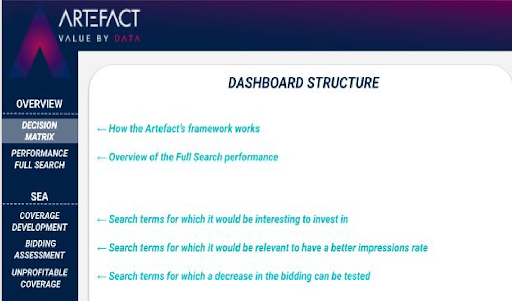SEO und SEA sind zwei Hebel mit ähnlicher Natur: beide reagieren auf eine einzige Nutzeranfrage. Dennoch werden sie von Werbetreibenden und Agenturen oft getrennt behandelt. In den letzten Jahren hat der Markt potenzielle Synergien erforscht, um Themen wie Investitionsrationalisierung, Markenschutz und den Kampf gegen die Keyword-Kannibalisierung anzugehen.
Die ständige Weiterentwicklung der SERP (Search Engine Result Pages), die unterschiedlichen Ansätze der beiden Disziplinen und die Herausforderung einer gemeinsamen Messung machen es schwierig, diese Fragen zu lösen. So sehr, dass viele Werbetreibende die Schaffung von Synergien zwischen den beiden Hebeln für einen unmöglichen, utopischen Traum halten. Doch bei Artefact ist die SEO/SEA-Synergie Realität. Wir haben sie von unseren Suchteams entwickelt und nennen sie "Full Search".
Könnte Full Search oder eine integrierte SEO- und SEA-Strategie der neue heilige Gral der leistungsbezogenen Investitionsoptimierung sein?
Unsere Vision basiert auf drei Hauptphasen:
Diskussion über die zu wählende Strategie der integrierten Suche
Erörterung der Strategie der integrierten Suche, die zusätzlich zu den anfänglichen SEA- und SEO-Strategien anzuwenden ist, anhand einer fortgeschrittenen Analyse der bestehenden Situation, die in Form einer Synergiematrix dargestellt wird:

Diese Matrix besteht aus drei Themen, die sowohl für SEA als auch für SEO gelten und die je nach Werbetreibenden, Tätigkeitsbereich und SERP-Status angepasst werden können.
Marketing-Analyse
Zu den wichtigsten Marketing-Kontrollpunkten, die hier analysiert werden, gehören Fragen der Komplementarität der semantischen Hebel und der Analyse der Inhalte von Anzeigen und Snippets.
Nehmen wir das Beispiel eines Schauspielers aus der Unterhaltungsbranche, für den Artefact kürzlich ein Audit durchgeführt hat:
Die Sichtbarkeit dieses Kunden bei bestimmten Suchanfragen, die sich auf seinen Tätigkeitsbereich bezogen, war weder bei SEO noch bei SEA optimal. Artefact schlug daher vor, dass der Werbetreibende neue SEA-Keywords und einen "direkteren" Hebel testet und anschließend deren Leistung analysiert.
Wenn die Ergebnisse gut waren, wurden SEO-Seiten erstellt, während weiterhin in SEA geboten wurde, solange diese neuen Seiten in den SERP aufstiegen. Wenn die Ergebnisse enttäuschend waren, wurden andere Keywords getestet.
Technische Analyse
Diese Analyse besteht aus der Bewertung des Status der SEA/SEO-Landingpages und der Ladezeiten der Seiten. Um diese beiden Fälle zu veranschaulichen, betrachten wir das Beispiel einer Website, die derzeit migriert wird.
In diesem Zusammenhang besteht das Hauptziel darin, die Konsistenz von Inhalt, Technik und Ladezeiten zu gewährleisten, um den organischen Verkehr aufrechtzuerhalten. Die Lösung für die vollständige Suche besteht darin, SEO zu unterstützen, indem die SEA-Gebote angepasst werden, um einen Rückgang der Positionierung auszugleichen.
In diesem Fall kompensiert die SEA jeden potenziellen Verlust an Sichtbarkeit und Verkehr auf unmittelbare, flexible und kontrollierte Weise.
Leistungsanalyse
Die Leistungsanalyse besteht aus einer Bestandsaufnahme der jeweiligen Indikatoren der beiden Hebel sowie aus einem Element, das wir Full Search Visibility nennen. Dieses Element wird über die Analyse der SEO/SEA-Erfassungsrate berechnet, mit der wir den Anteil des Suchvolumens messen können, der von den Hebeln in einem gemeinsamen semantischen Universum erfasst wird.
Dieser Indikator wird dann in einen Full Search-Entscheidungsbaum integriert, der über die Klassifizierung von Schlüsselwort-Universen eine strategische Ausrichtung für jede Situation bestimmt und damit verbundene Aktionen definiert.
A Vollständige Suche Mess- und Analysephase
Eine Full Search Mess- und Analysephase mit der Implementierung eines Dashboards, das die Überwachung gemeinsamer Messindikatoren sowie deren Entwicklung im Laufe der Zeit ermöglicht, um die Entscheidungsfindung zu erleichtern und kurz-, mittel- und langfristige Empfehlungen auszusprechen. Je nach Reifegrad des Werbetreibenden und der Komplexität der Synergien wird ein mehr oder weniger komplexes Dashboard eingerichtet.

Oben sehen Sie ein Beispiel für eine fortgeschrittene Dashboard-Struktur, die vom Artefact analytics-Team entwickelt wurde. Dieses Dashboard basiert auf verschiedenen data Quellen wie Google Ads oder Google Search Console, um nur einige zu nennen. Es wurde entwickelt, um die Semantik zu bündeln, um die Leistung besser zu überwachen und die operative Entscheidungsfindung zu erleichtern. Diese Dashboards können mit Markttools erweitert werden, die wettbewerbsfähige Berichte bieten.
Eine operative Einführungsphase durch die Durchführung von A/B-Tests auf der Grundlage der im Vorfeld ausgesprochenen Empfehlungen.
So hat Artefact einem seiner Kunden geholfen, den Wert des Kaufs seiner Marke in SEA zu ermitteln. Diese Frage ist für die meisten Werbetreibenden von entscheidender Bedeutung, da die mit den Marken verbundenen Volumina in Bezug auf den Verkehr und den Umsatz so bedeutend sind. Um dieses Problem anzugehen, ist es wichtig, die Fähigkeit der SEA zu messen, die verlorenen Volumina im Falle einer Unterbrechung der SEA zurückzugewinnen, und die Synergie der beiden Hebel aufzuzeigen.
Dieser Test hat gezeigt, dass SEO nicht das gesamte Volumen wiederherstellt, da ein Rückgang von etwa 20 % der Sitzungen und des Umsatzes verzeichnet wurde. Je nach Tätigkeitsbereich des Werbetreibenden, der Stärke der Marke und dem Testzeitraum können die Ergebnisse sehr unterschiedlich ausfallen. Daher ist es unerlässlich, die zu messenden Indikatoren im Voraus festzulegen, sich möglicher methodischer Verzerrungen bewusst zu sein (z. B. Schwierigkeiten bei der Schätzung des SEO-Umsatzes) und vor allem diese Tests ein- oder zweimal pro Jahr in verschiedenen Zeiträumen zu wiederholen.
Schlussfolgerung
Wie wir gezeigt haben, ist die SEO/SEA-Synergie, oder die vollständige Suche unter Artefactkeine Utopie ist. Sie ist jedoch eine strategische, operative und quantifizierbare Realität. Um das Beste aus dieser Synergie herauszuholen, darf sie bestehende SEO/SEA-Strategien nicht kannibalisieren, sondern muss immer auf einer iterativen Test- und Lernlogik beruhen. Auf diese Weise kann Full Search erfolgreich zur kontinuierlichen Anpassung von Optimierungen eingesetzt werden.

 BLOG
BLOG







